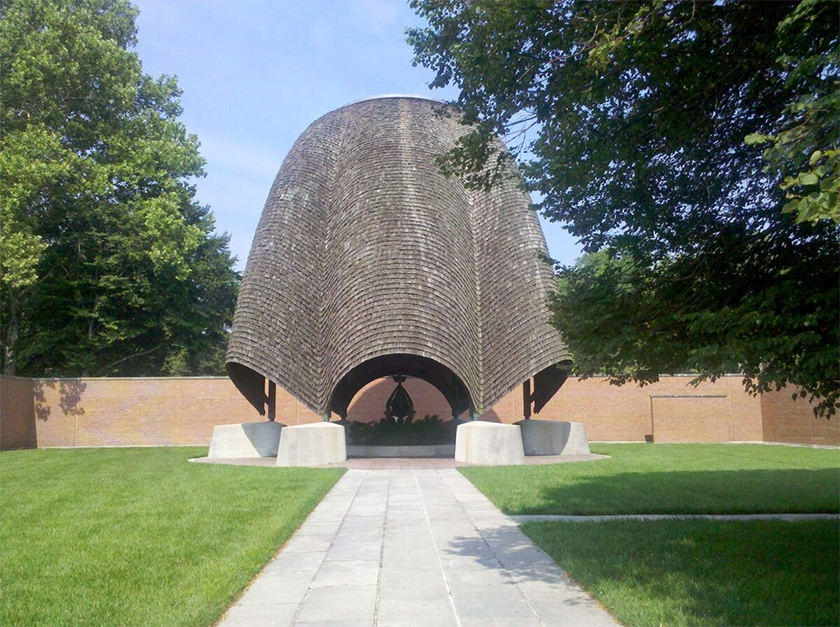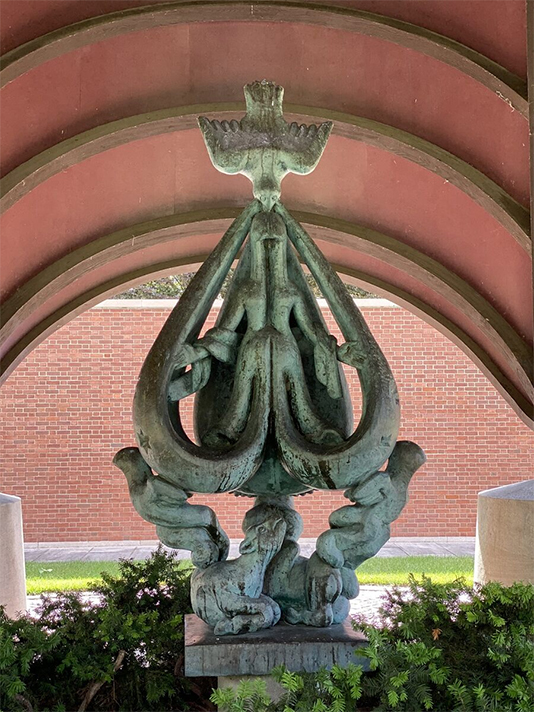
The Roofless Church is on the National Register of Historic Places list.
Image courtesy of: Atlas Obscura, photographed by: Eames Demetrios
Surprisingly, New Harmony, Indiana is home to an unconventional church that is in fact not even a building. The Roofless Church is an open-air cathedral that invites all faiths to worship under the world’s biggest roof… the sky.
Designed by the famous architect Philip Johnson, the Roofless Church is more than just the open-air, non-denominational building; it also encompasses the surrounding landscaped space. The site is surrounded by a brick wall, concrete pathways and golden rain trees. It is the domed cedar shingled canopy at the church’s “center” that is the area’s focal point!

A model of Philip Johnson’s Roofless Church design.
Image courtesy of: Smithsonian
The history behind New Harmony is a quite interesting. The story involves Robert Owen, a wealthy industrialist who became interested in social theory and took it upon himself to change the atrocious labor conditions at a Scottish mill… all while managing to increase the mill’s profits. At the New Lanark mill, the minimum age was raised to ten, a sort of health insurance was initiated, and working hours were shortened. Rather than productivity decreasing in the wake of these changes, productivity increased.
As such Owen realized that via changing people’s working conditions, lives can be changed for the better and thus, peoples’ characters became better. This was the final part of the equation… character formation should be happiness. Owen said, “Happiness will be the only religion of man.”
Owen and similar “thinkers” of the time became known as socialists because they owned a theory of society. Luckily, Owen was able to really test his theory in 1824 when he purchased the entire town of Harmony, Indiana. This purchase set Owen up to conduct America’s first secular utopian experiment.

The Roofless Church’s shingle roof.
Image courtesy of: Architecture Indiana
Sadly, the experiment failed for a number of reasons… mainly, it was unrealistic for Owen to presume that what worked in a small town in Scotland would seamlessly translate to a town in Indiana. The town’s residents were farmers and mechanics who did not feel as though they could join this new “community of equals.” These “lower class” residents resented the high brow speech, table manners, and rituals that were “imposed” upon them by the town’s leaders.
After Owen’s death, his widow, Jane Blaffer Owen, commissioned Philip Johnson to construct a lasting reminder of her husband’s desire for a place of inspiration. In 1960, Johnson’s concept of one roof… the sky… that encompasses all worshiping humanity was built.

The sculpture has also been called “The Virgin.”
Image courtesy of: Atlas Obscura, photographed by: Eames Demetrios
Johnson’s dome was built in the form of an inverted rosebud, which tied it to the New Harmony Community of Equals whose symbol was the rose. The curved parabola dome also served as a protective covering for a beautiful piece by the Cubist sculptor, Jacques Lipchitz. “The Descent of the Holy Spirit” sits prominently at the center of the dome.
About his statue, Lipchitz said, “My statue really represents a dove who has in his beak three parts of the sky which form a mantle from which the Virgin emerges, her hands generously opened for all humanity.” The dove’s eyes are open because, “We see only with the eyes of the Spirit.”
Lipchitz further said, “The eyes of the sacrificial lamb are closed and the Virgin Mary has no eyes at all because “The dove, or the Holy Spirit, alone sees.”

The surrounding gardens…
Image courtesy of: Atlas Obscura, photographed by: Eames Demetrios
It is important to note that Johnson and his client, Jane Blaffer Owen, dreamt up the actual “church” as the entire plaza-like area within the brick walls. The Robert Lee Blaffer Foundation, a foundation that was set up in order to preserve, promote, and financially support the various historic and educational attributes of New Harmony, Indiana maintains, “Johnson and client Jane Blaffer Owen envisioned a church where the only roof large enough to encompass a world of worshippers was the sky.”